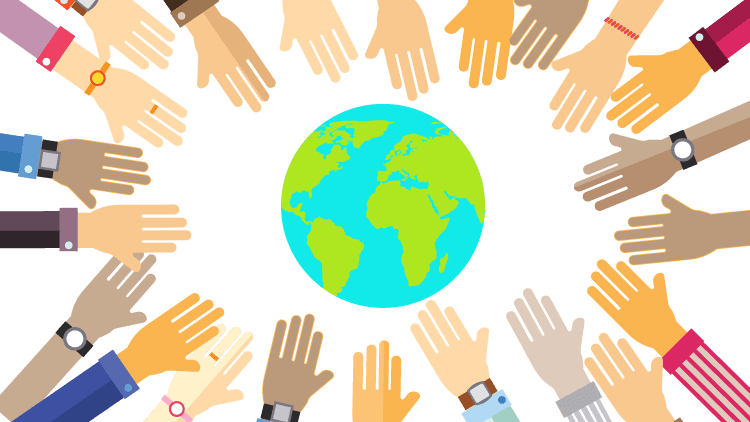
Language diversity
Language diversity
There have been many debates about language diversity and the likeliness of loosing this diversity. A U.N. independent expert says that there is a real possibility that half of the world’s languages will disappear by the end of the century.
Languages and their diversity
Language diversity is a wide concept to understand and even wider to contain it; we can come across more and more languages as we reach out to more people. Not everyone can understand every language nor can they learn every language, so at some level, we can still experience that barrier of language as we communicate or socialize in a place where diversity level is high. Even some countries have more regional languages than their citizens can learn. It is something that we cannot overcome or stop from happening, but we can do what we do best; come up with a solution.
Translation is the solutions to the parts of the worlds, where this can be a problem. USA translate provides you with the best translation services as they create high-quality content and stick with the route of the documents they are translating. With the best and dedicated team of translators, USA Translate is what you need.

What is the decisive factor when it comes to dying languages?
- Is it due to official policies? Some countries promote an official language in order to make administrative matters easier.
- Is it for national unity and territorial integrity? This is most common in countries that have conflicts in their past and officials believed that language unification is the first step of assuring cultural integrity.
- Is it linked to biodiversity? Researchers say that from the 6,900 languages spoken on Earth over 4,800 are in regions containing high biodiversity and the decline of these environments results in the loss of dialects.
Some people have argued that groups that are vulnerable to language loss will just become bilingual and rare or isolated languages will not disappear, they will rather spread. But this means that it is expected for groups that are in danger of losing their environment or are under language policy pressure to just mingle and adapt without considering cultural loss. These are inextricably linked to language and culture diversity and only united communities are able to maintain their culture untouched.
Why USA Translate?
USA Translate provides high quality translation services in over 120 languages and our translators are trained to take language diversity and localization into account when doing their job.
Considering the needs of the masses, we support almost all languages spoken globally. Be it Asian, African, Middle Eastern, European or any other region-specific language, whichever it may be, we make sure to have it all covered.
Having more than 3,000 translators, we can assure you that the type of translation you require can best be available at our doorstep. You have to struggle no more once you reach us, we take you ahead and beyond in all capacities.
With the wide array of translation services we offer, USA Translate supports more than 120 languages. What more do you want when we are offering all that you need?
We can help you connect with a translator of your targeted language, assisting in overcoming the communication barrier you might be facing and allowing you to interact with the prospective culture in a highly professional manner!
We can help you localize your business as we support and pair languages on a wide scale. It’s often times hard to get around to your targeted niche because of the language limitations. Don’t get that hold of you because that is what we are here for, to overcome your limitations and provide world-class solutions.
Localizing a business is basically integrating it into a culture completely and that is what we help you do. Not just translation but incorporating completely so that people can relate to what you want to convey.
We are available 24/7, and we provide an expert solution to your translation needs, overcoming the daunting challenges and coping up with the world in almost ALL region-specific languages.
Linguistic and Cultural Diversity in Language Learning
Linguistic diversity and cultural diversity play crucial roles in shaping the language learning experience. For English language learners and those studying foreign languages, understanding the nuances of their native language and non-native language is essential. Human languages, encompassing a vast array of language families, reflect our genetic diversity and environmental factors. Addressing language barriers and leveraging common language and academic language can significantly impact the success of English-language learners. Utilizing language portraits and acknowledging preferred language can enhance the learning process, ensuring that language learning accommodates and celebrates the rich tapestry of linguistic diversity.
Language is a key component of cultural identity and heritage. Preserving linguistic diversity is essential for maintaining the cultural richness and history of different communities. Many languages are endangered, with a significant number of them at risk of disappearing. Efforts to document and revitalize these languages are crucial for cultural preservation. Community-based initiatives, language education programs, and government policies that support linguistic diversity can help safeguard endangered languages. Promoting the use of minority languages in media, literature, and daily life also contributes to their preservation. By valuing and protecting linguistic diversity, societies can honor and celebrate their cultural heritage.
Promoting Diversity and Inclusion in the Translation Industry
Adhering to the APA bias-free language guidelines is crucial for fostering an inclusive environment within the translation industry. The association between language diversity and effective communication is highlighted by university research teams, including those from Boston University, which emphasize the importance of considering communities of color in their studies. International university research underscores the need for diversity in translation, demonstrating that diverse linguistic backgrounds can enhance understanding of climatic variables, landscape factors, and landscape variables. Supported by organizations like the National Institutes of Health, these initiatives advocate for racial color blindness and inclusivity, ensuring that translation services are accessible and respectful to all individuals.
Societies play a crucial role in promoting and protecting language diversity. This can be achieved through policies that support the use and teaching of multiple languages, funding language preservation initiatives, and recognizing minority languages in official domains. Media and technology also have a significant role in sustaining language diversity by providing platforms for the dissemination and exchange of diverse linguistic content. Encouraging cultural exchange and respecting linguistic rights are essential for maintaining a linguistically diverse world. Governments, educational institutions, and communities must work together to ensure that all languages are valued and preserved, fostering a richer and more inclusive global society.
Impact on Cognitive and Social Development
Research has shown that language diversity can have profound effects on cognitive and social development. Multilingual individuals often exhibit enhanced cognitive abilities, such as improved memory, problem-solving skills, and creativity. These cognitive benefits arise from the brain’s ability to juggle multiple linguistic systems, enhancing mental flexibility and executive function. Additionally, exposure to multiple languages fosters social skills by promoting empathy and better communication. Children who grow up in multilingual environments are more adaptable and open-minded, which prepares them for global citizenship. They develop a greater appreciation for different cultures and viewpoints, leading to increased cultural sensitivity and awareness.
Language Diversity in Education
Incorporating language diversity in education is crucial for promoting inclusivity and improving academic outcomes. Bilingual and multilingual education programs help students from diverse linguistic backgrounds access the curriculum more effectively. These programs also benefit native speakers by exposing them to different languages and cultures, fostering a more inclusive and respectful learning environment. Effective implementation of language diversity in schools requires trained teachers, appropriate resources, and supportive policies. Educational institutions that embrace language diversity can better cater to the needs of all students, ensuring that no child is left behind. Furthermore, these programs prepare students for a globalized world where multilingualism is an asset.
Challenges in a Multilingual Workplace
Language diversity in the workplace presents both opportunities and challenges. A multilingual workforce can lead to a more innovative and dynamic work environment by bringing together diverse perspectives and ideas. However, it can also cause communication barriers and misunderstandings if not managed properly. Employers can address these challenges by providing language training, promoting cultural sensitivity, and using translation and interpretation services. By creating an inclusive workplace that values linguistic diversity, companies can enhance employee satisfaction and productivity. Effective communication strategies, such as clear language policies and the use of technology, can also help overcome language barriers.
Language Diversity and Globalization
In an increasingly globalized world, language diversity is both a challenge and an asset. While globalization tends to favor dominant languages, it also creates opportunities for languages to intersect and influence each other. Businesses, international organizations, and educational institutions must navigate this linguistic landscape by adopting strategies that promote multilingualism. Recognizing the value of language diversity can enhance cross-cultural communication, improve international relations, and drive economic growth by reaching broader markets. Embracing multilingualism can lead to better customer service, more effective marketing strategies, and stronger international partnerships. In this context, language diversity becomes a crucial factor in fostering innovation and global collaboration.
Educational Approaches to Language Diversity
Educational institutions have a profound responsibility to promote language diversity and multilingualism, recognizing that these efforts can significantly enhance both individual and societal development. Bilingual and multilingual education programs are essential for supporting the academic success of students from diverse linguistic backgrounds, as they provide instruction in students’ native languages, ensuring that they do not fall behind due to language barriers. These programs are not only beneficial for non-native speakers but also enrich the educational experience of all students by fostering language skills, cultural awareness, and cognitive flexibility.
Curriculum development in such programs should actively incorporate diverse linguistic and cultural perspectives, helping students appreciate and respect the vast array of languages and cultures that exist in the world. This inclusion encourages students to develop a global outlook, essential in an increasingly interconnected world. To effectively implement these curricula, teacher training programs must equip educators with the skills and knowledge necessary to teach in multilingual classrooms. This includes training in language pedagogy, cultural competence, and strategies for managing diverse classrooms.
Language Diversity in Media and Technology
Media and technology play a pivotal role in promoting and preserving language diversity. The internet and digital platforms provide opportunities for the dissemination of content in multiple languages, reaching global audiences. Social media, online news outlets, and streaming services can offer multilingual content that reflects the diversity of their users. Language technology, such as translation software and multilingual user interfaces, enhances accessibility and usability for non-native speakers. Additionally, language preservation initiatives can leverage digital archives and databases to document and promote endangered languages. By embracing linguistic diversity, media and technology can foster a more inclusive digital environment.
Legal and Administrative Implications of Language Diversity
Language diversity also holds profound legal and administrative implications, particularly in multilingual societies where equitable access to government services is crucial. Government agencies face the responsibility of ensuring that all citizens can fully participate in civic life regardless of their native language. This involves translating essential documents such as legal texts, official forms, and public announcements into multiple languages. Moreover, legal systems must accommodate linguistic diversity by providing interpretation services in courts and making legal representation accessible to non-native speakers.
Policies that recognize and safeguard minority languages play a pivotal role in upholding the rights of linguistic communities. By promoting linguistic accessibility in legal and administrative proceedings, societies can foster principles of justice, equity, and social inclusion. This approach not only ensures that all individuals can understand and exercise their legal rights but also strengthens democratic values by supporting diverse cultural expressions within the framework of the law.
Language Diversity and Health Care
In the health care sector, language diversity is crucial for providing quality care to patients from diverse linguistic backgrounds. Effective communication between healthcare providers and patients is essential for accurate diagnosis, treatment, and patient compliance. Language barriers can lead to misunderstandings, misdiagnoses, and decreased patient satisfaction. Healthcare institutions must employ multilingual staff or provide translation and interpretation services to ensure clear communication. Training healthcare professionals in cultural competence and language skills is also vital for delivering culturally sensitive care. By addressing language diversity, health care systems can improve health outcomes and ensure equitable access to services for all patients.
Language Diversity and Economic Growth
Language diversity significantly contributes to economic growth and development, offering both businesses and economies a distinct competitive advantage. Multilingual capabilities enable businesses to seamlessly enter new markets and engage with a wider customer base, which is crucial in today’s globalized economy. Companies that can communicate effectively in multiple languages are better positioned to understand local consumer behavior, preferences, and cultural nuances, which in turn informs more effective and targeted marketing strategies. This localized approach ensures that products and services resonate with diverse audiences, increasing the potential for market penetration and growth.
Furthermore, language diversity enhances customer service, allowing businesses to provide support in the preferred languages of their clients. This personalized approach to customer service significantly increases customer satisfaction and loyalty, leading to higher sales and long-term revenue growth. When customers feel understood and valued, they are more likely to return and recommend the business to others, creating a positive cycle of growth and brand loyalty.
In addition to these external benefits, language diversity within the workforce brings a wealth of skills and perspectives that drive innovation and creativity. Multilingual employees are able to bridge communication gaps, collaborate more effectively with international teams, and contribute to a more dynamic and inclusive workplace. This diversity of thought fosters creativity and problem-solving, which are essential for innovation and staying competitive in the market.
The Future of Language Diversity
The future of language diversity depends on concerted efforts by governments, communities, and individuals to promote and protect linguistic diversity. Globalization, technological advancements, and social changes pose both challenges and opportunities for language diversity. Policies that support multilingualism, language education, and cultural exchange are essential for sustaining linguistic diversity. Embracing linguistic diversity can lead to more inclusive and dynamic societies, where different languages and cultures coexist harmoniously. The recognition of the value of linguistic diversity in various sectors, including business, education, health care, and media, will be key to fostering a more inclusive and interconnected world.
The Role of Translation and Interpretation Services
Translation and interpretation services are vital for bridging language gaps in various contexts, including business, education, health care, and legal settings. Professional translators and interpreters possess the linguistic skills and cultural knowledge necessary to provide accurate and contextually appropriate translations. Their expertise ensures that communication is effective and that the intended message is conveyed correctly. In a globalized world, the demand for translation and interpretation services continues to grow, highlighting their importance in facilitating cross-cultural communication. Investing in high-quality translation services can enhance international relations, support economic growth, and promote social cohesion by overcoming language barriers.
Frequently Asked Questions
What is language diversity?
Language diversity refers to the presence of multiple languages within a specific region, community, or globally. It encompasses the variety of languages spoken by people from different cultural, ethnic, and social backgrounds. This diversity contributes to the richness of human communication, cultural heritage, and social interactions.
Why is language diversity important?
Language diversity is important because it preserves cultural heritage, promotes mutual understanding, and enhances cognitive abilities. It allows for the expression of unique worldviews and knowledge systems, fostering innovation and creativity. Additionally, language diversity is crucial for maintaining social cohesion and respect for different cultural identities.
How does language diversity impact education?
Language diversity impacts education by requiring educational systems to accommodate students who speak different languages. This includes implementing bilingual or multilingual education programs, providing language support services, and training teachers to handle diverse classrooms. Embracing language diversity in education can improve academic outcomes and promote inclusivity.
What challenges are associated with language diversity in the workplace?
Language diversity in the workplace can present challenges such as communication barriers, misunderstandings, and cultural differences. To address these challenges, companies can implement language training programs, promote cultural sensitivity, and employ translation and interpretation services. These measures help create a more inclusive and productive work environment.
How can societies promote and protect language diversity?
Societies can promote and protect language diversity by implementing policies that support the use and teaching of multiple languages. This includes funding language preservation programs, encouraging multilingual education, and recognizing minority languages in official documents and media. Promoting cultural exchange and respecting linguistic rights are also essential steps in safeguarding language diversity.

